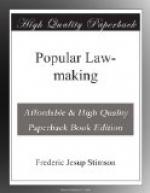[Footnote 1: Census Reports, 1909, “Marriage and Divorce,” part I, p. 15.]
Only Japan shows a number of divorces approaching these figures. She has two hundred and fifteen per one hundred thousand of general population,—about the same as Indiana, which stands eighth in the order of States. But with the exception of Japan no civilized country shows anything like the proportion of divorces that the American States do. Thus, in Great Britain and Ireland there are but two per hundred thousand of population; in Scotland, four; in the German Empire, fifteen; in France, twenty-three, and in the highest country of all, Switzerland, thirty-two, while the average of the entire United States is seventy-three.
The census figures as to the trades or professions in which divorce is most prevalent are amusing, but probably not very significant. It appears, as might be expected, that actors and actresses stand at the head, and next musicians or teachers of music; while clergymen stand very near the bottom of the list, only excelled in this good record by bar-tenders (in Rhode Island) and, throughout the country, by agricultural laborers.
But after all, more important, perhaps, than even marriage and divorce, are the great social changes which arise from the general engaging of women in industrial occupation. In matters of property right we have found they are substantially already on an equality with men, if not in a position of special privilege. Yet, as Herbert Spencer remarked, “When an abuse which has existed for many centuries is at last on the point of disappearing, the most violent outcry is made against it.” During the century when women were really oppressed,[1] under the power of the husband, given no rights as to their property, their children, or hardly even as to their person, no complaint was heard. Whereas to-day the cry of unjust legislation almost rises to a shriek. The movement for the emancipation of women originated, of course, with Mary Wolstonecraft, about 1812. Her book, which was the first, is certainly one of the longest that have yet been written on the subject. It remained at the time unanswered, and when its author married Godwin she herself seems to have lost interest in the controversy. Nevertheless, little has been added since to the ideas there put forward, save, indeed, for the vote. It is a somewhat curious fact that in all Miss Wolstonecraft’s great magazine of grievances and demands for remedying legislation, there is not a single word said about votes by women, or there being such a thing as the right to the ballot.
[Footnote 1: In the trial of Mary Heelers for bigamy (2 State Trials, 498) as late as 1663 the chief justice said, ’If guilty, she must die; a woman hath no clergy.’ Yet Mary wrote to her husband, in court, “Nay, my lord, ’tis not amiss, before we part, to have a kiss!” She was acquitted.]




